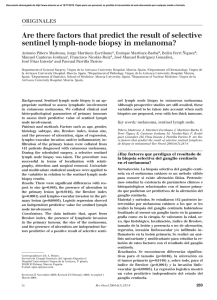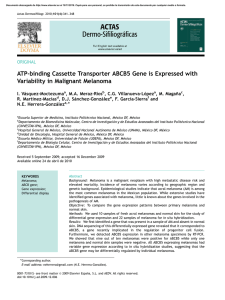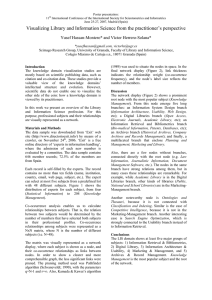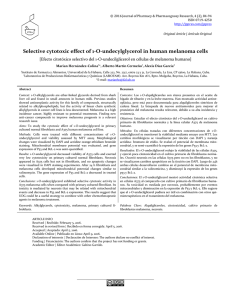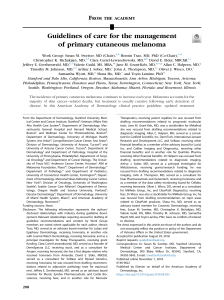Descriptive Study of the Costs of Diagnosis and Treatment
Anuncio
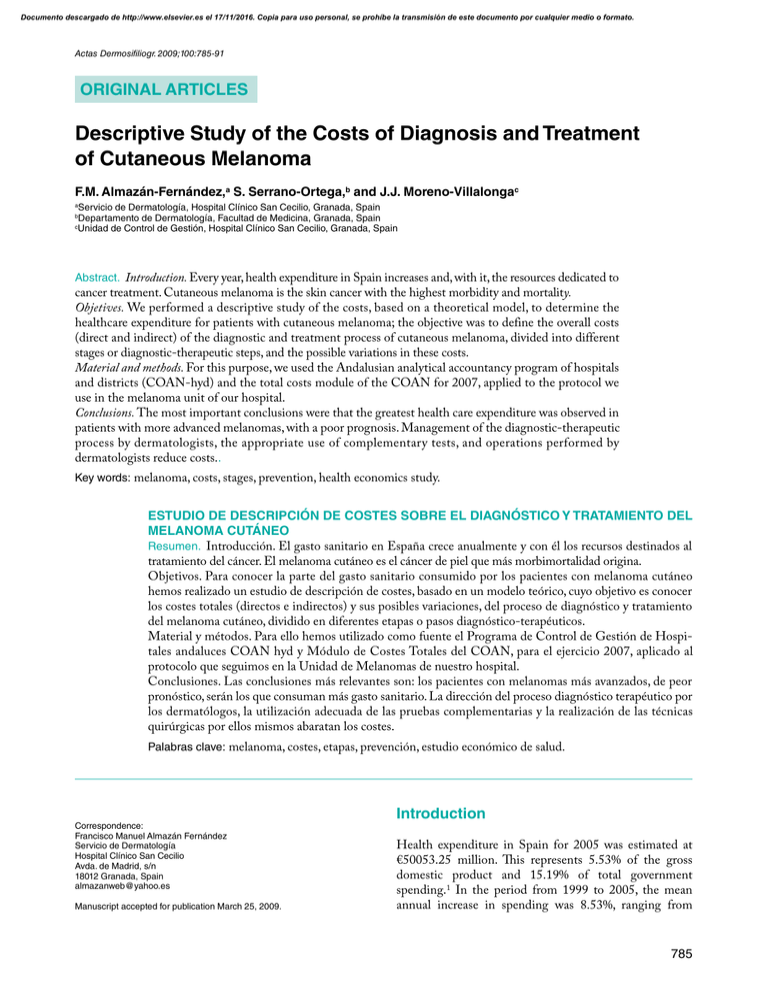
Documento descargado de http://www.elsevier.es el 17/11/2016. Copia para uso personal, se prohíbe la transmisión de este documento por cualquier medio o formato. Actas Dermosifiliogr. 2009;100:785-91 ORIGINAL ARTICLES Descriptive Study of the Costs of Diagnosis and Treatment of Cutaneous Melanoma F.M. Almazán-Fernández,a S. Serrano-Ortega,b and J.J. Moreno-Villalongac a Servicio de Dermatología, Hospital Clínico San Cecilio, Granada, Spain Departamento de Dermatología, Facultad de Medicina, Granada, Spain Unidad de Control de Gestión, Hospital Clínico San Cecilio, Granada, Spain b c Abstract. Introduction. Every year, health expenditure in Spain increases and, with it, the resources dedicated to cancer treatment. Cutaneous melanoma is the skin cancer with the highest morbidity and mortality. Objetives. We performed a descriptive study of the costs, based on a theoretical model, to determine the healthcare expenditure for patients with cutaneous melanoma; the objective was to define the overall costs (direct and indirect) of the diagnostic and treatment process of cutaneous melanoma, divided into different stages or diagnostic-therapeutic steps, and the possible variations in these costs. Material and methods. For this purpose, we used the Andalusian analytical accountancy program of hospitals and districts (COAN-hyd) and the total costs module of the COAN for 2007, applied to the protocol we use in the melanoma unit of our hospital. Conclusions. The most important conclusions were that the greatest health care expenditure was observed in patients with more advanced melanomas, with a poor prognosis. Management of the diagnostic-therapeutic process by dermatologists, the appropriate use of complementary tests, and operations performed by dermatologists reduce costs.. Key words: melanoma, costs, stages, prevention, health economics study. ESTUDIO DE DESCRIPCIÓN DE COSTES SOBRE EL DIAGNÓSTICO Y TRATAMIENTO DEL MELANOMA CUTÁNEO Resumen. Introducción. El gasto sanitario en España crece anualmente y con él los recursos destinados al tratamiento del cáncer. El melanoma cutáneo es el cáncer de piel que más morbimortalidad origina. Objetivos. Para conocer la parte del gasto sanitario consumido por los pacientes con melanoma cutáneo hemos realizado un estudio de descripción de costes, basado en un modelo teórico, cuyo objetivo es conocer los costes totales (directos e indirectos) y sus posibles variaciones, del proceso de diagnóstico y tratamiento del melanoma cutáneo, dividido en diferentes etapas o pasos diagnóstico-terapéuticos. Material y métodos. Para ello hemos utilizado como fuente el Programa de Control de Gestión de Hospitales andaluces COAN hyd y Módulo de Costes Totales del COAN, para el ejercicio 2007, aplicado al protocolo que seguimos en la Unidad de Melanomas de nuestro hospital. Conclusiones. Las conclusiones más relevantes son: los pacientes con melanomas más avanzados, de peor pronóstico, serán los que consuman más gasto sanitario. La dirección del proceso diagnóstico terapéutico por los dermatólogos, la utilización adecuada de las pruebas complementarias y la realización de las técnicas quirúrgicas por ellos mismos abaratan los costes. Palabras clave: melanoma, costes, etapas, prevención, estudio económico de salud. Introduction Correspondence: Francisco Manuel Almazán Fernández Servicio de Dermatología Hospital Clínico San Cecilio Avda. de Madrid, s/n 18012 Granada, Spain almazanweb@yahoo.es Manuscript accepted for publication March 25, 2009. Health expenditure in Spain for 2005 was estimated at €50053.25 million. his represents 5.53% of the gross domestic product and 15.19% of total government spending.1 In the period from 1999 to 2005, the mean annual increase in spending was 8.53%, ranging from 785 Documento descargado de http://www.elsevier.es el 17/11/2016. Copia para uso personal, se prohíbe la transmisión de este documento por cualquier medio o formato. Almazán-Fernández FM et al. Descriptive Study of the Costs of Diagnosis and Treatment of Cutaneous Melanoma 7.29% in 2001 to 11.37% in 2003. In 2005, health expenditure increased by 8.38%. he Spanish autonomous regions and cities, which control 91% of public health expenditure, determine how the system evolves as a whole and according to its constituent parts. In Andalusia, public health expenditure totaled €7528.686 million in 2005.2 his amounts to approximately 16% of the healthcare budget assigned to the autonomous regions and cities of Spain. Almost 10% of the €50 000 million currently budgeted for healthcare in Spain is allocated to the treatment of cancer, which also accounts for 15% of the total budget for hospital drug treatment in Spain. Ninety percent of the budget for cancer treatment is allocated to care during the last 6 months of a patient’s life, and 46% of this cost is employed in the last 60 days. If we extrapolate these igures to the Autonomous Community of Andalusia, €750 million are spent on the ight against cancer. Nonmelanoma skin cancer (NMSC) is the most common type of skin cancer and also the most common of all cancers in human beings. In contrast, cutaneous melanoma is less common, with a prevalence of 1.3% to 2.5% of all malignant tumors in Spain.3 However, the mortality associated with this type of tumor is very high. he natural course of melanoma includes 3 phases of disease progression: invasion, local growth, and lymphatic and hematogenous spread. his behavior will determine which diagnostic and treatment strategies should be employed. hese strategies will involve a variety of steps over time and will be associated with very similar costs among patients, determined by a diagnostic–therapeutic algorithm for cutaneous melanoma. his is the basis for the study described here, employing a theoretical model but also taking into account possible variations that the reader will be able to extrapolate to each particular case. In this way, we can gain an overall picture of the healthcare expenditure incurred by each individual patient with cutaneous melanoma. Objectives he following objectives were deined for this study: determine the overall health expenditure from the moment a patient with melanoma enters a melanoma clinic, passing through the entire therapeutic process, until the patient completes follow-up (either as a result of discharge or death) and identify diferences in diagnostic and therapeutic approaches that could lead to variation in costs. Materials and Methods he prices for the diferent sections are publically available and were obtained from the Andalusian analytical 786 accounting program of hospitals and districts (COANhyd) and the total costs module of the COAN for 2007. We performed an analysis of the cost of the diferent procedures involved in the diagnosis, treatment, and follow-up of cutaneous melanoma based on data from Hospital Clínico San Cecilio in Granada, Spain. To this end, we estimated the total cost of the following items: 1. Cost of the irst appointment with the diferent specialist services 2. Cost of follow-up appointments 3. Cost of diagnostic tests 4. Cost of outpatient surgery 5. Surgical day hospital costs 6. Cost of interventions involving hospital admission (mean stay, 4.1 days) 7. Cost of treatment with interferon (IFN) and dacarbazine (as monotherapy) 8. Costs associated with oncology day hospitals Personnel-related costs (salaries, nursing staf, ancillary staf, porters, and operating theater cleaning staf ) and upkeep of facilities were included in the diferent standards, since they took into account total costs (direct and indirect). We excluded external hospital costs and expenses incurred outside the melanoma unit (transport, personal expenses, health center appointments, etc). Digital dermoscopy does not have a speciic cost assigned, but the cost of the initial consultation includes diagnostic and therapeutic procedures, and this therefore covers dermoscopy. Diferences between specialties in the cost of initial consultations are due to inclusion of additional tests or drug treatment (oncology consultation) or to the diferent treatment approaches used (dermatology consultation), etc, as well as to maintenance of those services and other indirect expenses. he cost of surgical interventions requiring general anesthesia, postoperative care, and hospital admission (taking the mean stay as 4.1 days, which corresponds to the mean length of hospital admission associated with patients admitted for surgical intervention due to melanoma in 2007) is also included, along with personnel costs, in the corresponding standards. In order to standardize costs, possible diferences occurring outside the melanoma unit (previous biopsies, patients referred from primary care or other hospitals with the lesion excised, etc) were not taken into account. For similar reasons, the costs associated with day hospitals were included under surgical treatment without hospital admission (major outpatient surgery), given that this is the most common procedure in our department. We considered the following under standard assessment of disease progression: general laboratory workup, chest x-ray, and abdominal and pelvic ultrasound. he sum of these tests is calculated for the corresponding stages. Actas Dermosifiliogr. 2009;100:785-91 Documento descargado de http://www.elsevier.es el 17/11/2016. Copia para uso personal, se prohíbe la transmisión de este documento por cualquier medio o formato. Almazán-Fernández FM et al. Descriptive Study of the Costs of Diagnosis and Treatment of Cutaneous Melanoma he diagnostic–therapeutic stages or steps that were included in the analysis correspond in chronological order to the process that each patient would go through according to the characteristics of the melanoma, based on the model treatment algorithm that we used for the purposes of the study (Figure). he steps are as follows: 1. Step 1. Melanoma detection. Excision biopsy with 0.5 cm margins. 2. Step 2. Resection. a) Melanoma <1 mm (not included in step 2B): resection with 1 cm surgical margins. b) Melanoma >1 mm (or <1 mm with regression, ulceration, embolization, or Clark level III; or >4 mm with good general health): resection with 2 cm surgical margins and sentinel lymph node biopsy. c) Melanoma >4 mm (not included in step 2B): resection with 2 cm surgical margins and lymph node resection. 3. Step 3. Surgical treatment of lymphatic spread. a) Negative sentinel lymph node: follow-up assessments (Table 1). b) Positive sentinel lymph node or evidence of lymph node metastasis: lymph node resection. 4. Step 4. Oncologic treatment of metastatic melanoma. a) Lymph node metastases: IFN 20 mill/m2 × 5 days × 4 weeks. b) Visceral metastases: intravenous dacarbazine (the cost of this drug is based on monotherapy) 200 mg/m2 × 5 days and repeat the cycle every 21 days according to treatment response and tolerance. We considered the diferent steps to be completed either at the time results are provided or during assessment immediately following treatment, on a case-by-case basis. Other follow-up appointments were considered separately, since their number and cost vary according to the individual characteristics of the patient and tumor. Data were provided by the Management Control Department of Hospital Clínico San Cecilio in Granada, Spain. Results Costs Associated With Each Step An in situ melanoma would not go beyond the first step (Table 2) and the patient would enter follow-up (Table 3). The cumulative cost of a standard assessment of disease progression (chest x-ray, abdominal and pelvic ultrasound, and general laboratory tests) is shown in Tables 3 and 4. Suspicion of melanoma Excision biopsy with 0.5 cm margins and pathology study Melanoma Breslow depth <1 mm* Resection with 1 cm margins Breslow depth 1–4 mm Resection with 2 cm margins Follow-up Resection with 2 cm margins SLNB –ve Lymph node Visceral metastases Breslow depth >4 mm* Lymph node resection/SLNB +ve Lymph node –ve Lymph node IFN Assess IFN Dacarbazine Figure. Diagnostic and treatment algorithm. Asterisk indicates that certain cases may be selected for sentinel lymph node biopsy (see indications); IFN, interferon; SLNB, sentinel lymph node biopsy. Actas Dermosifiliogr. 2009;100:785-91 787 Documento descargado de http://www.elsevier.es el 17/11/2016. Copia para uso personal, se prohíbe la transmisión de este documento por cualquier medio o formato. Almazán-Fernández FM et al. Descriptive Study of the Costs of Diagnosis and Treatment of Cutaneous Melanoma Table 1. Follow-up and Additional Tests Second year Table 3. Step 2 First year Medical history and physical examination 6 months Stage IB-III First year Second year Subsequent years Medical history and physical examination 3 months 6 months Annual Blood tests 6 months Annual Annual Chest x-ray 6 months Annual Annual >1 mm thickness (or <1 mm with regression, ulceration, embolization, or Clark level III; or >4 mm with good general health) Abdominal ultrasound/CT... Annual Annual Annual Anesthetist appointment €27.32 Preanesthetic assessment (x-ray, ECG, blood tests) €59.87 Annual Subsequent years A Stage IA Table 2. Step 1 Laboratory tests (CBC, biochemistry, coagulation) Day hospital €156.86 Major outpatient surgery (resection with 1 cm surgical margins) €169.74 Annual Abbreviation: CT, computed tomography. First appointment <1 mm thickness €131.31 €14.60 Histology €86.88 Provision of results €32.83 Total B Nuclear medicine study €265.19 Inpatient procedure (resection with 2 cm surgical margins and SLNB) €682.24 Histology €86.88 €32.83 Day hospital €156.86 Provision of results Major outpatient surgery (excision biopsy with 0.5 cm surgical margins) €169.74 Total Histology €86.88 Provision of results €32.83 Total €592.22 Abbreviation: CBC, complete blood count. The cumulative costs (steps 1 and 2) are as follows: a) step 1 + 2A, €1038.53; b) step 1 + 2B, €1746.55; and c) step 1 + 2C, €1481.36 (cumulative costs with standard assessment of disease progression [chest x-ray, abdominal and pelvic ultrasound, and standard laboratory tests]). Table 4 shows the costs associated with step 3. If there is clinical suspicion or radiographic evidence of lymph node metastasis, fine-needle aspiration is performed to confirm the diagnosis prior to lymph node excision. The procedure costs €139.01. The potential cumulative costs (step 1 + step 2 + step 3) are as follows: 1. Patients with invasive melanoma <1 mm thick in whom follow-up reveals evidence of lymph node metastases: step 1 + step 2A + fine needle aspiration + step 3B = €2066.68 (cumulative cost with standard assessment of disease progression [chest x-ray, abdominal and pelvic ultrasound, and standard laboratory tests]). 788 €446.31 €1154.33 C >4 mm thickness Anesthetist appointment €27.32 Preanesthetic assessment (x-ray, ECG, blood tests) €59.87 Analysis of disease progression: Chest x-ray Abdominal and pelvic ultrasound CT with contrast enhancement MRI with contrast enhancement PET CBC and biochemistry €17.95 €71.79 €233.32 €466.64 €432.17 €10.97 Standard assessment of disease progression (x-ray, ultrasound, CBC, and biochemistry) €100.71 Inpatient procedure (resection with 2 cm margins and lymph node excision) €682.24 Histology €86.88 Provision of results €32.83 Total €889.14 Abbreviations: CBC, complete blood count; CT, computed tomography; ECG, electrocardiogram; MRI, magnetic resonance imaging; PET, positron emission tomography; SLNB, sentinel lymph node biopsy. Actas Dermosifiliogr. 2009;100:785-91 Documento descargado de http://www.elsevier.es el 17/11/2016. Copia para uso personal, se prohíbe la transmisión de este documento por cualquier medio o formato. Almazán-Fernández FM et al. Descriptive Study of the Costs of Diagnosis and Treatment of Cutaneous Melanoma Table 4. Step 3 A Table 5. Step 4 Negative sentinel lymph node or no evidence of lymph node metastasis A Lymph node metastasis (IFN) Oncology consultation €418.83 Follow-up process (see follow-up appointments section) B IFN treatment (5 days × 4 weeks) €3796.80 Positive sentinel lymph node or evidence of lymph node metastasis Oncology day hospital (5 days × 4 weeks) €2241.47 Anesthetist appointment Oncology follow-up Preanesthetic assessment (x-ray, ECG, blood tests) Total Analysis of tumor extension: Chest x-ray Abdominal and pelvic ultrasound CT with contrast enhancement MRI with contrast enhancement PET CBC and biochemistry Standard assessment of disease progression (x-ray, ultrasound, CBC, and biochemistry) Inpatient procedure (lymph node excision) B €17.95 €71.79 €233.32 €466.64 €432.17 €10.97 100,71 euros Histology €86.88 Provision of results €32.83 Total €889.14 Abbreviations: CT, computed tomography; ECG, electrocardiogram; MRI, magnetic resonance imaging; PET, positron emission tomography.. 2. Patient with melanoma >1 mm thick, with a positive sentinel lymph node: step 1 + step 2B + step 3B = €2635.69 (cumulative costs with standard assessment of disease progression [chest x-ray, abdominal and pelvic ultrasound, and standard laboratory tests]). 3. Patient with melanoma >1 mm thick with negative sentinel lymph node biopsy but who has evidence of lymph node metastasis during follow-up: step 1 + step 2B + ine needle aspiration + step 3B = €2774.70 (cumulative cost with standard assessment of disease progression [chest x-ray, abdominal and pelvic ultrasound, and standard laboratory tests]). he cost of step 4, shown next, must be added to these costs, along with subsequent follow-up in all cases and prior assessments in the second and third cases (Table 5). A patient with lymph node metastasis may generate the following total cumulative costs. a) Melanoma <1 mm thick with lymph node metastasis: step 1 + step 2A + ine needle aspiration + step 3B + step 4A = €8523.78 (cumulative cost with standard assessment of disease progression [chest x-ray, abdominal and pelvic ultrasound, and standard laboratory tests]). b) Melanoma >1 mm thick with lymph node metastasis: step 1 + step 2B +/– ine needle aspiration €6457.10 Visceral metastases (dacarbazine monotherapy) Oncology consultation €418.83 Dacarbazine treatment (1 cycle = 5 days) €54.25 Oncology day hospital (5 days) €563.50 Oncology follow-up €104.71 Total €682.24 €104.71 €1036.58 Abbreviation: IFN, interferon. + step 3B + step 4A = €9092.79 (+ €139.01 if ine needle aspiration is performed) (cumulative cost with standard assessment of disease progression [chest x-ray, abdominal and pelvic ultrasound, and standard laboratory tests]). c) Melanoma >4 mm thick in which a decision is taken to perform lymph node excision due to evidence of lymph node metastasis: step 1 + step 2C + step 4A = €7938.46 (cumulative cost with standard assessment of disease progression [chest x-ray, abdominal and pelvic ultrasound, and standard laboratory tests]). Until visceral metastasis has been demonstrated in a patient, there are various possibilities for treatment and follow-up, and total costs must be calculated by adding the steps followed in each individual case. Depending on the response and tolerance of the patients, dacarbazine can continue to be administered in treatment cycles. Consequently, a cost of €617.75 per cycle should be added to the results shown. Cost of Follow-up Appointments As shown in Table 1, the number of follow-up appointments and the tests required will depend on the characteristics of the melanoma. he cost of a follow-up appointment represents 25% of the cost of the irst appointment: €32.82 for a dermatology consultation and €104.71 for an oncology consultation. To this we must add the cost of additional tests considered necessary for assessment of disease progression in each patient (Table 6). Actas Dermosifiliogr. 2009;100:785-91 789 Documento descargado de http://www.elsevier.es el 17/11/2016. Copia para uso personal, se prohíbe la transmisión de este documento por cualquier medio o formato. Almazán-Fernández FM et al. Descriptive Study of the Costs of Diagnosis and Treatment of Cutaneous Melanoma Table 6. Cost of Diagnostic Tests X-ray €17.95 Abdominal and pelvic ultrasound €71.79 CT with contrast enhancement €233.32 MRI with contrast enhancement €466.64 PET €432.17 CBC and biochemistry €10.97 Abbreviations: CBC, complete blood count; CT, computed tomography; MRI, magnetic resonance imaging; PET, positron emission tomography. Discussion Cutaneous melanoma is less common than other types of skin cancer, such as squamous or basal cell carcinoma. Although it accounts for 1.3% to 2.5% of malignant tumors in Spain,3 the mortality associated with this tumor is much higher. he treatment of cutaneous melanoma has undergone various changes over time,4 including changes in the size of surgical margins during resection, introduction of sentinel lymph node biopsy, and the development of new chemotherapy regimens. he appearance of new imaging techniques, such as dermoscopy, ultrasound, and magnetic resonance imaging, has also enhanced diagnosis and staging in these patients. hese diagnostic and therapeutic techniques, as a whole and in diferent combinations, have contributed along with available scientiic evidence to the development of clinical practice guidelines for the management of melanoma. here are currently few diferences between hospitals in the approach to treatment of cutaneous melanoma, and in general, the same treatment algorithms are employed. Nevertheless, diferences may be present in the use of resources, for instance, if we take into account the activities of general surgeons, plastic surgeons, or other professionals in part of the therapeutic process (principally tumor surgery, sentinel lymph node biopsy, or lymph node excision), the use of diferent assessments of disease progression, employing a more or less comprehensive preoperative study of the patients (particularly during step 1), or if use is made of a day hospital or diferent oncologic treatment regimens. hese potential diferences in practice result in variation in the use of healthcare resources between diferent hospitals. For instance, during 2007 (the year used as a reference for the costs presented here), sentinel lymph node biopsy and lymph node excision were performed in the melanoma unit of the department of dermatology at Hospital Clínico San Cecilio. his has ofered a series of advantages. Firstly, there has been no need for delay in surgical treatment, and secondly, there has been a reduction in costs, given that other specialists have not been involved and additional irst appointments or 790 follow-up consultations in other departments have not been required for the procedure to be carried out. Clearly, although the dermatologist must have appropriate surgical training,5 some disciplines are more surgical than others, and the question of whether or not a dermatologist should carry out sentinel lymph node biopsy or lymph node excision is beyond the scope of this discussion. We must nevertheless ensure that we do not lose sight of the patient as the primary focus. herefore, the appropriate surgical technique should always be performed by the most qualiied professional with the most extensive experience. Wherever possible, this should be done using the least amount of healthcare resources. In those patients in whom sentinel lymph node biopsy is indicated (step 2B), the costs are higher than if lymph node excision is performed (step 2C or 3B). his technique requires collaboration among a multidisciplinary team that includes a dermatologist, a surgeon (who may also be the dermatologist), a specialist in nuclear medicine, and a pathologist. Each member of the team plays a fundamental role in the diferent elements of the technique: patient selection, presurgical lymph node assessment, surgical detection, sentinel lymph node excision, and histologic study.6 he high cost of this procedure is justiied in patients with melanoma who meet a series of characteristics in which it is indicated (American Joint Committee on Cancer melanoma staging system, as reported by Mangas et al6): Breslow depth >1 mm, Clark level >III, or ulceration. A patient with visceral metastasis who receives treatment with dacarbazine will incur a lower inancial cost than a patient who requires treatment with IFN. his is for a number of reasons. Firstly, dacarbazine is cheaper (the cost of a single cycle of IFN would cover the cost of 9 cycles of dacarbazine), and 10-year survival is 5% in patients with stage IV disease, compared with 20% to 60% in patients with stage III disease.7 his results in fewer follow-up appointments (both in oncology services and in the melanoma unit), additional tests, etc. Depending on treatment response and patient tolerance, both IFN and dacarbazine can continue to be administered in cycles, and this would represent an additional cost on top of those described in this study. Such an increase in costs will be compounded if dacarbazine is used according to the Dartmouth regimen (dacarbazine, cisplatin, carmustine, and tamoxifen) instead of as monotherapy. In addition, some patients with stage IV disease may have metastases that are candidates for surgical excision. hose metastases that can be surgically excised with local anesthesia represent an additional cost equivalent to step 1. In contrast, those requiring general anesthesia and hospital admission due to their greater degree of complexity (intransit metastases in which the pathway must be resected, diicult to excise subcutaneous nodules, etc) may carry a similar cost to that associated with step 2C or 3B. Actas Dermosifiliogr. 2009;100:785-91 Documento descargado de http://www.elsevier.es el 17/11/2016. Copia para uso personal, se prohíbe la transmisión de este documento por cualquier medio o formato. Almazán-Fernández FM et al. Descriptive Study of the Costs of Diagnosis and Treatment of Cutaneous Melanoma Follow-up appointments, which are considered separately here with the exception of those to give results, vary according to the patient and the characteristics of the melanoma. hose patients with worse prognosis, namely, those with more advanced disease, and who do not die as a result of the disease will also consume more resources due to follow-up, since more appointments will be needed than in patients with less advanced disease and better prognosis. Furthermore, a greater number of more expensive tests will be required in patients with more advanced disease. Consequently, a patient with lower-risk melanoma will require less expensive treatment and will use fewer resources in follow-up appointments and additional tests. In addition to these costs, we must also take into consideration those which are incurred outside the melanoma unit and which are very common in daily practice: costs associated with ambulance transport, medication, etc, along with those costs associated with primary care or general dermatology consultations. Since there is no assigned cost for dermoscopy, it was included in this study as part of the initial consultation, without any added cost. However, for those patients undergoing digital follow-up, particularly those with additional risk factors, and who develop melanoma, the healthcare costs will be greater than in those referred directly to the melanoma unit at the time of diagnosis. Health economic studies of metastatic melanoma (which incurs the highest costs) have not shown treatments to be cost-efective. Consequently, better treatments will be required to increase survival and quality of life.8 Furthermore, unlike in the case of breast or cervical cancer, screening procedures have not proved efective for the early detection of melanoma in some countries, although appropriate randomized studies are still necessary to address their usefulness in the population at risk.9 Some questions remain to be answered, such as when, by whom, how, and in which individuals should screening be carried out.10 Once its efectiveness has been demonstrated, we could consider the costs that it would incur. Nevertheless, in Australia, the prevention campaigns that have been implemented in recent years have yielded beneits. Although, as in most countries, the incidence of melanoma continues to rise, this increase has been reduced by as much as half in comparison to other countries.11 In the population aged less than 40 years (particularly women), the incidence of melanoma has stabilized, unlike in older patients. Furthermore, there is greater detection of noninvasive melanoma thanks to these campaigns aimed at prevention and raising awareness.11 his would represent a signiicant saving in health expenditure, since there would be fewer patients requiring treatment, and in addition, melanoma would be detected at earlier stages, with the consequent reduction in the number of treatment steps and lower follow-up costs. In 2005, Hernández Martín et al12 carried out a study of NMSC that was methodologically similar to ours. he authors obtained the diferent costs from external or thirdparty invoicing (individuals not covered by the healthcare system, private companies, etc) by the accounts department of their hospital. In our study, expenditure was calculated according to the total cost (direct and indirect) in 2007 of the diferent elements of the clinical practice guidelines. Along with increased cost of living, diferences between autonomous regions, etc, this means that diferences may occur in the cost of similar diagnostic or therapeutic procedures. In conclusion, although we have presented a theoretical study based on isolated diagnostic and therapeutic steps, and taking into account the limitations that this implies, we have provided a picture of the total health expenditure incurred by a patient with a suspicious pigmented lesion who is subsequently diagnosed with melanoma. Conflicts of Interest The authors declare no conflicts of interest. References 1. h t t p : / / w w w. m s c . e s / e s t a d E s t u d i o s / e s t a d i s t i c a s / sisInfSanSNS/pdf/grupodeTrabajoSanitario2007.pdf 2. http://www.msc.es/estadEstudios/estadisticas/docs/ EGSP2005/esumenEGSP2005.pdf 3. Sáenz S, Conejo-Mir J, Cayuela A. Epidemiología del melanoma en España. Actas Dermosifiliogr. 2005;96:411-8. 4. Essner R. Surgical treatment of malignant melanoma. Surg Clin North Am. 2003;83:109-56. 5. Serrano S. La formación quirúrgica del dermatólogo. Actas Dermosifiliogr. 2008;99:669-70. 6. Mangas C, Paradelo C, Rex J, Ferrándiz C. La biopsia del ganglio centinela: su papel diagnóstico y pronóstico en el melanoma maligno. Actas Dermosifiliogr. 2008;99:331-48. 7. Balch CM, Soong S, Atkins MB, Buzaid AC, Cascinelli N,Coit DG, et al. An evidence-based staging system for cutaneous melanoma. CA Cancer J Clin. 2004;54:131-49. 8. Cashin RP, Lui P, Machado M, Hemels ME, Corey-Lisle PK, Einarson TR. Advanced cutaneous malignant melanoma: a systematic review of economic and quality-of-life studies. Value Health. 2008;11:259-71. 9. Koh H K. Melanoma screening. Arc h Der matol. 2007;143:101-3. 10. Marks R. Campaigning for melanoma prevention: a model f o r a h e a l t h e d u c a t i on p ro g r a m . J E u ro p Ac ad Dermatol.2004;18:44-7. 11. Whiteman DC, Bray CA, Siskind V, Green AC, Hole DJ, MacKie RM. Changes in the incidence of cutaneous melanoma in the west of Scotland and Queensland, Australia: hope for health promotion? Eur J Cancer Prevention. 2008;17:243-50. 12. Hernández Martín A, Núñez Reiz A, Sáiz Martínez M, Rovirosa i Juncosa J. Coste por proceso en el tratamiento quirúrgico del cáncer de piel. Gac Sanit. 2006;20:273-9. Actas Dermosifiliogr. 2009;100:785-91 791
